… at Lake Merritt in Oakland, California
I originally named this portrait “Standing Room Only.” I’d never seen a Black-crowned Night Heron (Nycticorax nycticorax) creep chest-high into a pool — then just stand there forever like a Japanese snow monkey. This pose made me laugh as I watched the heron soak up the swirls of his own private day spa. One of my Facebook friends wrote, “what is this lil man doing?” That comment captured the humor I saw in this stance. What *was* he doing?

When I first saw him creep into the ripples, I thought his intent was to bathe or fish.
He stood for a time, reflected in his own stillness as the ripples turned to velvet.
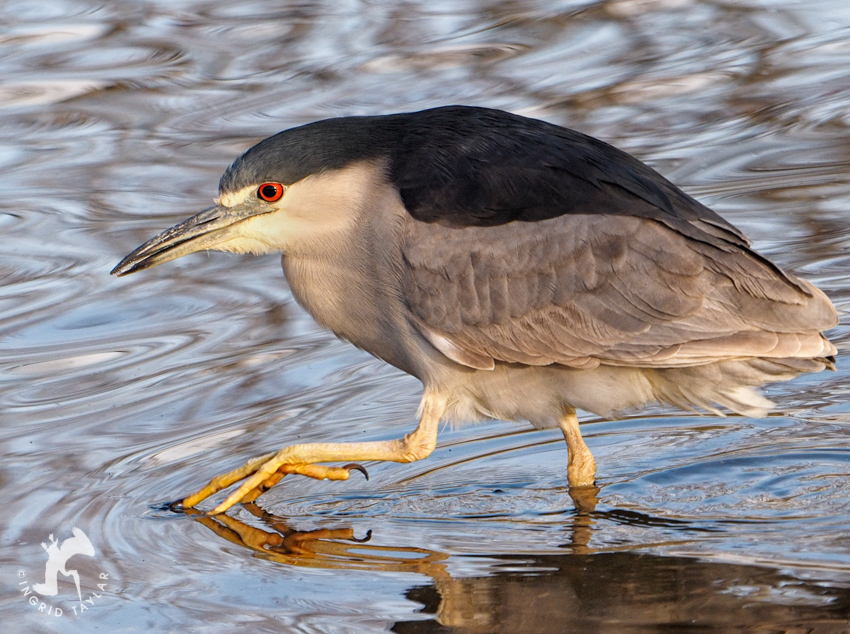
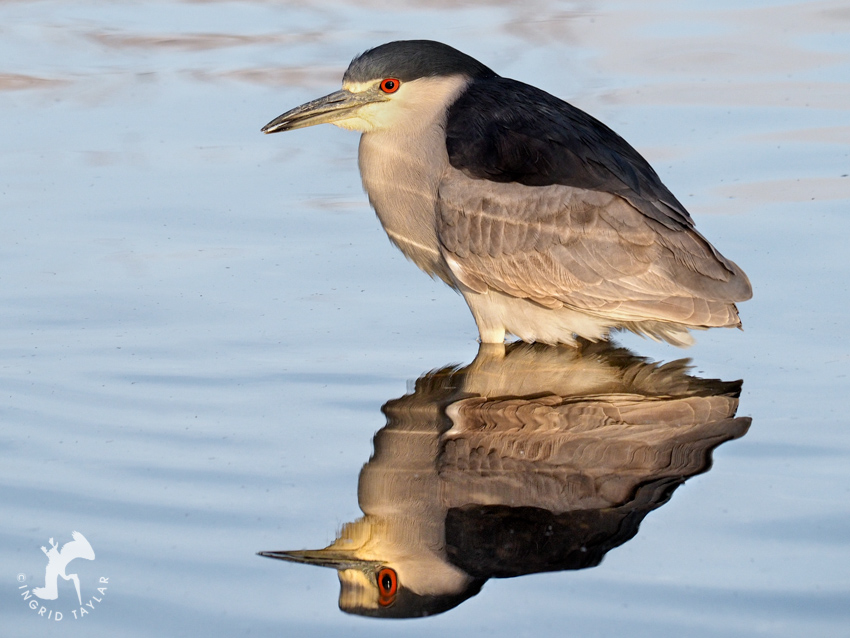
Then he moved into a shaded soak and did nothing but pivot … for minutes, then minutes again … turning 180 degrees right and left as the clouds passed over and mottled the light.
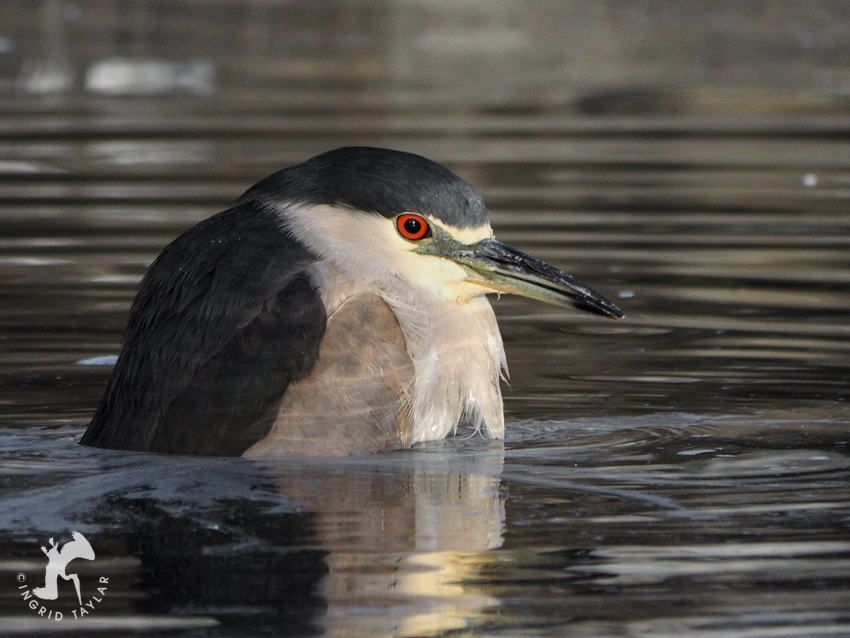
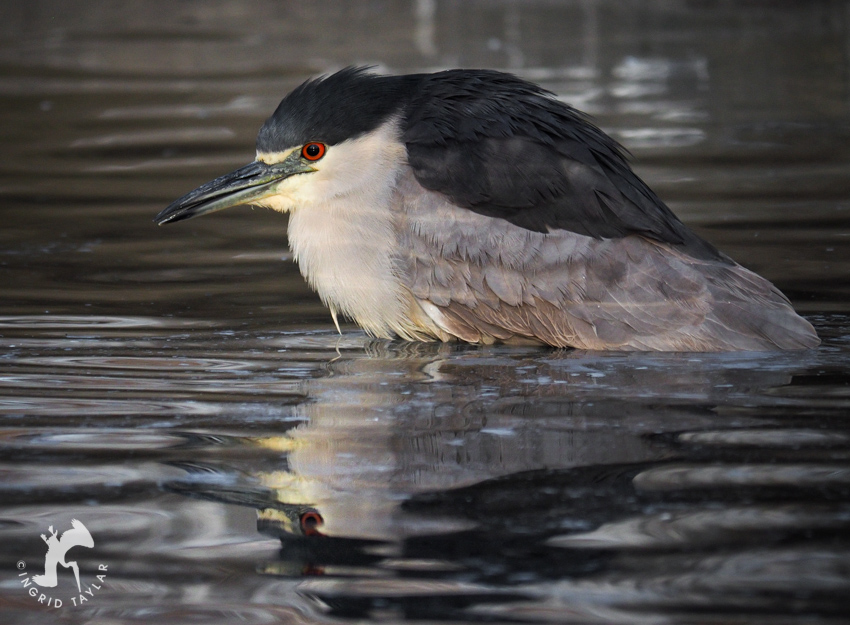
After pointing his bill in one direction for a while, he’d twist around again, capturing the glint of early evening in his crimson eyes.
Finally, the motive: He dipped his bill. It’s a bird’s poker tell — a bath about to break loose.
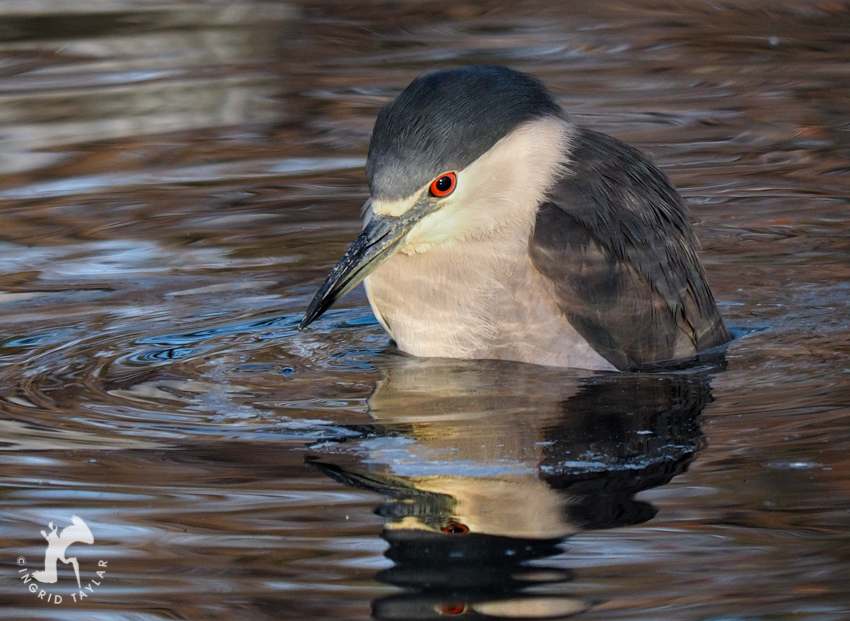
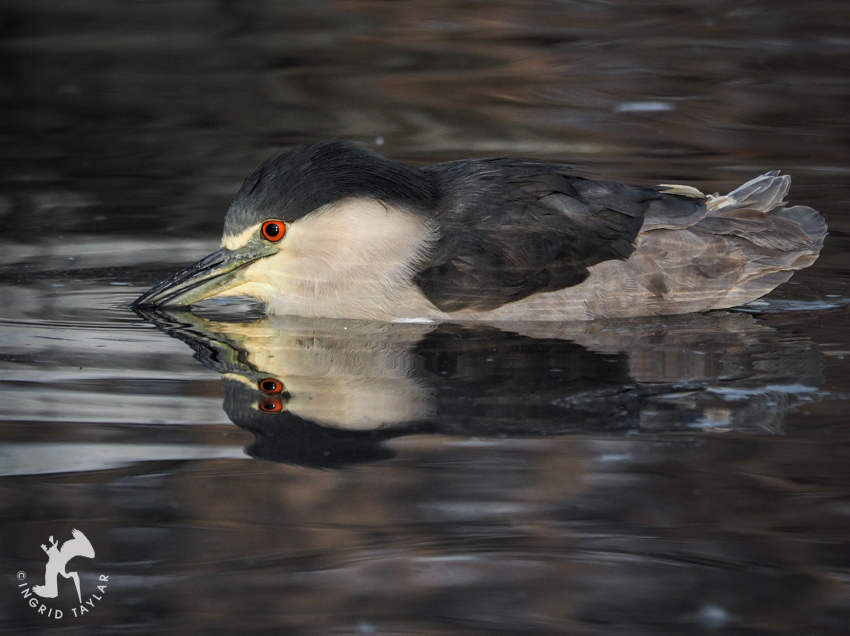
And it did …
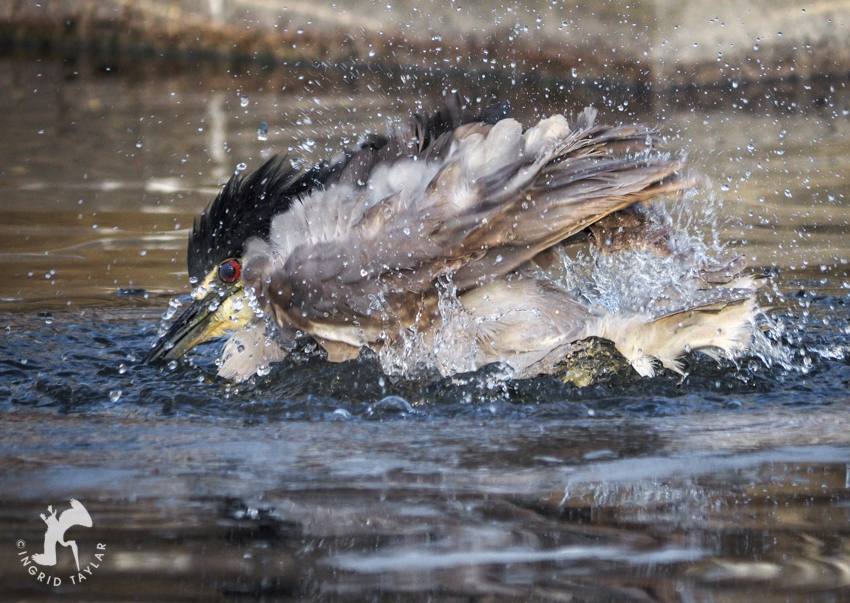
… leaving Sir Night Heron Snow Monkey with a red-carpet upsweep of a hairdo.
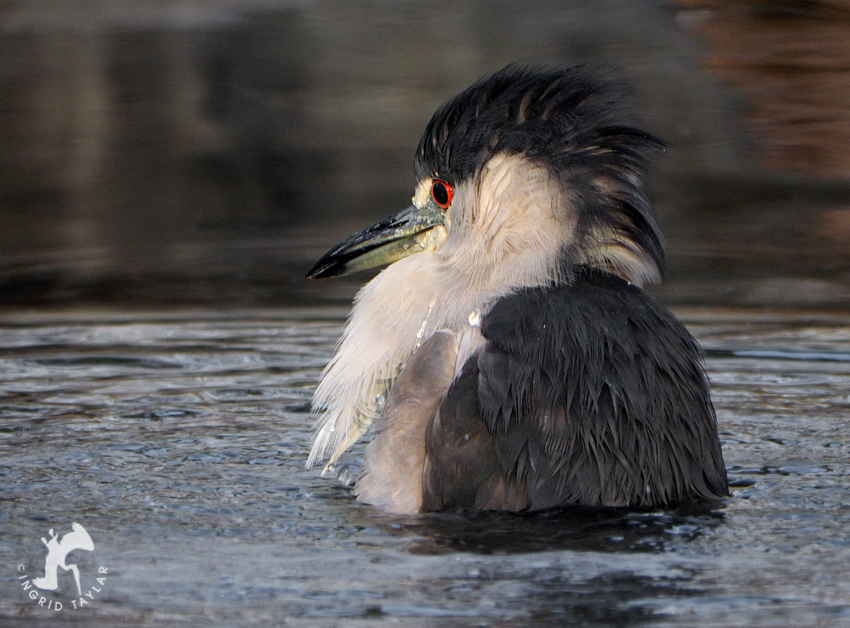
If it’s unfair to say “he” when he could be a she, it’s because Black-crowned Night Herons remind me of wizards, two feet tall and always in a low crouch — as if clutching alchemy vials in their claws.
[In response to Larry’s comment below, note the white head plume visible in breeding season. Both adult herons were photographed on the same day, at the same location.]
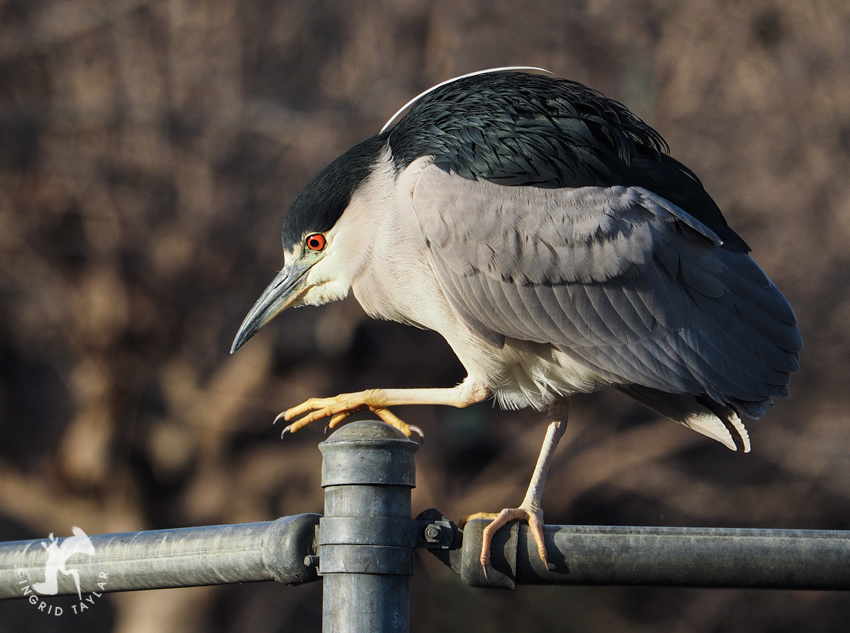
There’s also parity among the sexes, where both night heron parents are monogamous, share in incubating the eggs and then both regurgitate nutrients for their growing young ones to eat. The difference between male and female is a slight disparity in size, so although he isn’t she — nor vice versa — the ambiguity in identification might be understandable.
Black-crowned Night Herons exist on every continent except Australia and Antarctica. In the San Francisco Bay Area where I photographed this bathing bird, Black-crowned Night Herons become urban birds where their habitat overlaps the matrix of traffic and grit. The first night heron I saw after moving to the area was perched on a recycling bin in the middle of the night, in the middle of an Oakland sidewalk.
I photographed this heron below, one overcast morning a few years ago, enjoying some R&R on my car.
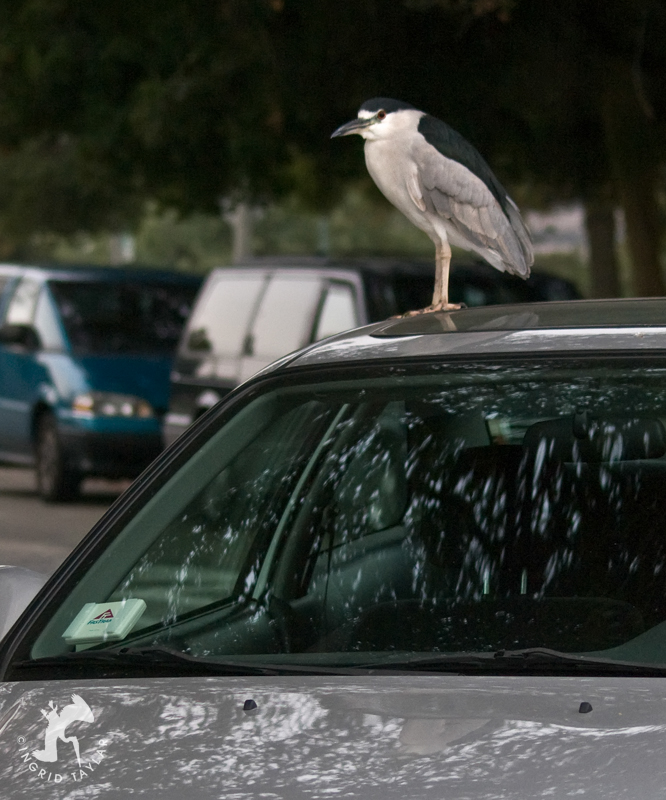
But you’ll just as often find them lurking in natural settings, foraging, resting and nesting in the green patches that encircle San Francisco Bay.
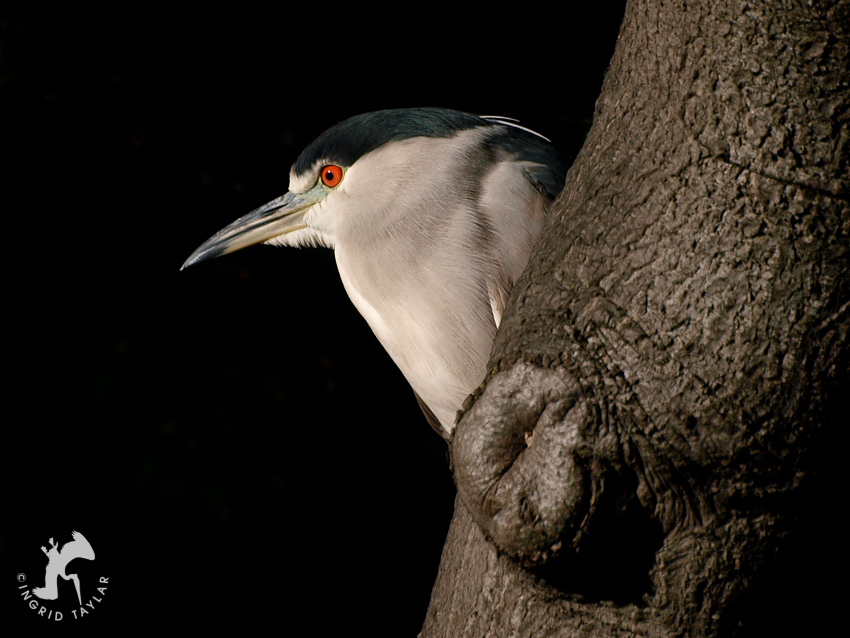
Juvenile night herons grow into their adult plumage over the span of three years. Their coloration is dramatically different with yellow and orange eyes accenting their brown and buffy fluff — which sometimes leads to identify confusion with other birds, like Yellow-crowned Night Herons.
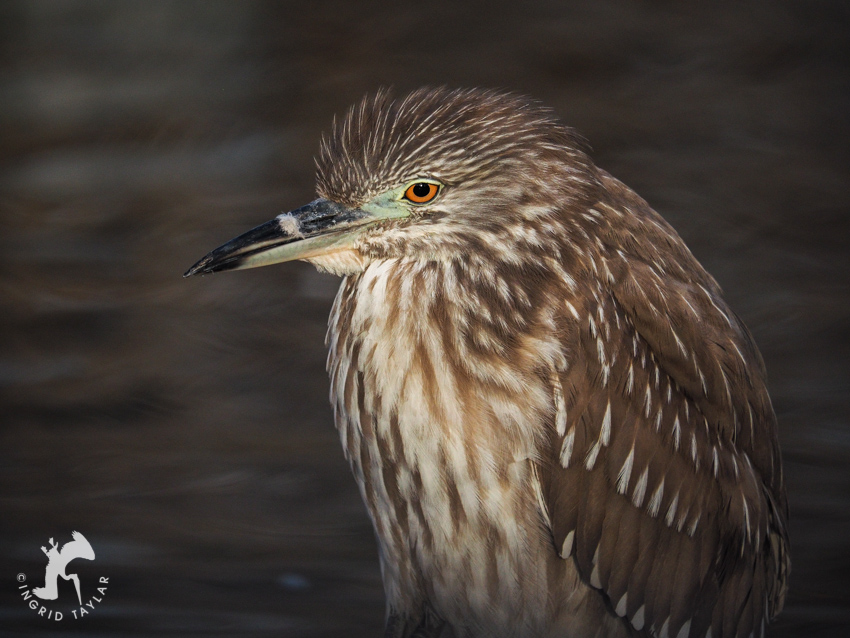
They’ll vibrate their bills to attract fish through disturbance, then dissolve even food as tough as bones in the potent acids of their digestive system. Although I often see night herons in the dusky dark hours as their name suggests, in full daylight I love watching them as I do other herons, retracted in silence like statues until the impulse to fish, bathe or soak like a snow monkey takes precedence.
[Adjustments: standard raw file edits, vignettes, cleanup of dust/spots]

I don’t think I have ever seen a Black-crowned Night-Heron standing in water that deep Ingrid! Your photos of these really cool birds are exceptional as always, but, as always, it’s your story telling that makes this tale so intriguing. Thank you also for the personal information on this species. I didn’t know that they vibrate their bills to attract fish nor that their digestive systems can dissolve bones!
I appreciate you including images of the birds in their non-breeding and their plumed breeding attire as well as showing us what their offspring look like. Love the shot of the bird atop your car too, but my favorite is the “stalking” heron stepping into the silvery blue water. Beautiful!
Larry, thanks so much for pointing out the head plumes the herons grow during breeding season. I didn’t think to identify them and will add a note to the post and will make note to do that in future posts.
That Zuiko 50-200mm f/2.8 lens is tack sharp Ingrid! Isn’t that the lens you used? I love all of them, they all tell a story so well.
Maria, I didn’t know how much I loved this lens until I got the E-M1. The combination exceeds anything I was able to shoot with my E-3. The first 10 photos are all E-M1 + Zuiko 50-200mm. The last (juvenile) is also the same combo. Of course, proximity helps, too, where you can fill the frame, even if it’s at full telephoto.
Once again- I love this story! Thank you for sharing this beautiful, contemplative, snow monkey of a Night Heron with us!
Elizabeth, sorry for the delayed reply! I let my blog lie fallow and was invaded by spam obstacles. Finally sifted through to the gems underneath. Thank you so much for this kindness.
Don’t understand the lens lingo, but I understand which one my favorite photo is: ALL OF THEM!!!!
Echoing Larry, I love the text (style and substance) that accompanies the images. Text alone is wonderful. Images alone are wonderful. The combination — oh, plus the subjects themselves — is what keeps me coming back for more.
Sending this off to sister now, and will point out the camera chatter between you two, Maria and Ingrid, because she will actually “get” it and maybe can learn something from it. 🙂
Hi, CQ … as I mentioned to Elizabeth … apologies for the late reply! Thank you for saying this. I’ve been in flux and in quandary over the love for my subjects and the limits of time. I’m attempting to repopulate here where I’ve been absent.
Absolutely brilliant series of photos and commentary. So many things to look for observing this species of heron. From a distance not so outstanding or eye catching. However, on closer inspection as you have shared stunning. The eyes, the breeding plume, The contrast of black and white with shades of gray. Glad you included the juvenile as I find that phase of feathering fascinating as well. I have been fortunate enough to observe them fishing at close hand. A juvie missing and missing when a nearby adult Green heron nailed a fish on every attempt. Thanks for sharing and yeah that camera/lens combination in your hands bring exemplary results.
This is amazing Ingrid. Thank you for sharing. Great story.
Hi, Peter … thanks for stopping by. Can’t believe you found my alter-ego here, away from Flickr. So glad to have made your acquaintance in the photographic sphere.
Wow. What an incredible story! It’s so fun to see wildlife behaving in unusual ways – it reminds us they are real, complicated living beings, not just generic species. Great comparison to the snow monkeys – a fascinating animal that learned to love hot baths. Most people tend to think birds are less-smart than mammals, but of course that is not the case at all. I once saw a video of a green heron “fishing” using a piece of bread to lure a fish. Amazing.
Beautiful photos, and great story! Thanks!
Hi again, Denise (as she answers comments in reverse order). I agree with you. It’s such a gift when we’re present for those anomalous events or behaviors. (I’ll look for that heron video, maybe it’s still up online.)
As far as bird intelligence, I’m so grateful to see science substantiating what many of us observe, which is that birds have a unique intelligence that is far greater than humans assumed. Not that intelligence should be a measure of value … but it’s certainly been used as a measure to devalue certain species.
I read somewhere, I’ll look for the reference, that some researchers discovered that birds compensate for brain size by having their intelligence, effectively, dispersed throughout their nervous system. It was a rather complex analysis that I’ve succeeded in rendering simplistic. I’ll post a reference if I can find it.